- MADE IN DESIGN lighting wall lamps DCW éDITIONS - LAMPES GRAS
- 46 products.
- 1
- 2
- 3
- Next
- Brand
- And Tradition
- Anglepoise
- Antonangeli
- Artemide
- Artuce
- Azimut Industries
- Belux
- Bloom!
- Catellani & Smith
- Compagnie
- Danese Light
- DCW éditions - Lampes Gras
- DCW éditions - Schottlander
- Delta Light
- Diesel with Foscarini
- Dix Heures Dix
- Fabbian
- Ferm Living
- Flos
- Flux
- Fontana Arte
- Forestier
- Foscarini
- Frama - Pop Corn
- Frandsen
- Gubi - Bestlite
- Gubi - Grossman
- House Doctor
- Ingo Maurer
- Innermost
- Jieldé
- Kartell
- La Corbeille
- Le Deun
- Lightyears
- Luceplan
- Lumen Center Italia
- Marset
- Moustache
- Nemo
- Northern Lighting
- Pa Design
- Petite Friture
- Pols Potten
- Prandina
- Roger Pradier
- Rotaliana
- Sarah Lavoine
- Seletti
- Slide
- Spécimen Editions
- Tom Dixon
- Tsé-Tsé
- Tunto
- Vibia
- Wästberg
 ArmchairsAudio speakers and soundBaggage, wash bags, pursesBar stoolsBaskets and storageBaskets, centerpieces, bowlsBathroom accessoriesBedsBedside tablesBenchesBinsBookcases and shelvesBooks, Dvd'sBowls and salad bowlsBoxes and jarsCandles and candle holdersChairs and high armchairsClocksCoat racks and pegsCoffee makersCoffee tablesConsole tableCorkscrewsCushionsDecoration boxesDecoration objectsDressers, chest of drawers, wardrobesHigh tables and barsHightech and connected objectsHousehold appliancesJewelryKidsKids furnitureKitchen knivesKitchenwareLight up furnitureLighting Bulbs and accessoriesLighting Ceiling lightsLighting Desk lampsLighting Floor lampsLighting LED lightsLighting Light up furniture and accessoriesLighting Outdoor lightsLighting SuspensionsLighting Table lampsLighting Wall lampsMemo boards, slates and calendarsMirrorsMiscellaneous furnitureOffice accessoriesOffice chairsOffice furnitureOthersOutdoor ArmchairsOutdoor BarbecuesOutdoor Chairs and high armchairsOutdoor Coffee tablesOutdoor Deco and accessoriesOutdoor Flowerpots and houseplantsOutdoor High tables and BarsOutdoor ParasolsOutdoor Poufs and cushionsOutdoor Reclining chairs / Sun loungersOutdoor ShowersOutdoor SofasOutdoor TablesPartitions, screens, room dividersPens and notebooksPetsPots and pansPots and plantsPoufsRadios and alarm clocksRugsShoe polisherShoesSofasStickers and wallpapersStoolsStorage furnitureSugar and cream bowlsTablesTablewareTableware AccessoriesTableware Bar, wine, aperitifTableware Bowls and salad bowlsTableware CarafesTableware CutleryTableware EggcupsTableware Fruit basketsTableware GlassesTableware Oil and vinegarTableware PlatesTableware SeasoningTableware Service cutleryTableware Serving platesTableware Tableclothes and napkinsTableware Tea and coffeeTableware Teacups and mugsTableware TraysTableware TrivetsTea towels and apronsTeapots and kettlesTextileTote bagTV tablesUseful and cleverVasesWatches
ArmchairsAudio speakers and soundBaggage, wash bags, pursesBar stoolsBaskets and storageBaskets, centerpieces, bowlsBathroom accessoriesBedsBedside tablesBenchesBinsBookcases and shelvesBooks, Dvd'sBowls and salad bowlsBoxes and jarsCandles and candle holdersChairs and high armchairsClocksCoat racks and pegsCoffee makersCoffee tablesConsole tableCorkscrewsCushionsDecoration boxesDecoration objectsDressers, chest of drawers, wardrobesHigh tables and barsHightech and connected objectsHousehold appliancesJewelryKidsKids furnitureKitchen knivesKitchenwareLight up furnitureLighting Bulbs and accessoriesLighting Ceiling lightsLighting Desk lampsLighting Floor lampsLighting LED lightsLighting Light up furniture and accessoriesLighting Outdoor lightsLighting SuspensionsLighting Table lampsLighting Wall lampsMemo boards, slates and calendarsMirrorsMiscellaneous furnitureOffice accessoriesOffice chairsOffice furnitureOthersOutdoor ArmchairsOutdoor BarbecuesOutdoor Chairs and high armchairsOutdoor Coffee tablesOutdoor Deco and accessoriesOutdoor Flowerpots and houseplantsOutdoor High tables and BarsOutdoor ParasolsOutdoor Poufs and cushionsOutdoor Reclining chairs / Sun loungersOutdoor ShowersOutdoor SofasOutdoor TablesPartitions, screens, room dividersPens and notebooksPetsPots and pansPots and plantsPoufsRadios and alarm clocksRugsShoe polisherShoesSofasStickers and wallpapersStoolsStorage furnitureSugar and cream bowlsTablesTablewareTableware AccessoriesTableware Bar, wine, aperitifTableware Bowls and salad bowlsTableware CarafesTableware CutleryTableware EggcupsTableware Fruit basketsTableware GlassesTableware Oil and vinegarTableware PlatesTableware SeasoningTableware Service cutleryTableware Serving platesTableware Tableclothes and napkinsTableware Tea and coffeeTableware Teacups and mugsTableware TraysTableware TrivetsTea towels and apronsTeapots and kettlesTextileTote bagTV tablesUseful and cleverVasesWatches
251.00 £
DCW éditions - Lampes Gras
DCW éditions - Lampes Gras Wall light Chromed Metal Long arm : L 38,8 cm / Short arm : L 20 cm - Shade : Ø 14 cm x H 17,5 cm In 1921 Bernard-Albin GRAS designed a series of lamps for use in offices and in industrial environments. The «GRAS» lamp, as it was subsequently called, was astounding in its simple, robust and yet very ergonomic design. There are neither screws nor welded joints in the basic form. In 1927 the RAVEL company purchased the patent and started production of the «GRAS» lamps. Bernard-Albin GRAS was one of the most innovative designer of the 20th century. The functional esthetic of his lamps and especially the design of details such as those of the arms, stems, brackets and bases were truly original and far ahead of his time. Early on Le Corbusier was seduced by the modern design and user-friendliness of the lamps and became one of Bernard-Albin GRAS's most enthusiastic supporters using the lamps in his own offices as well as employing them in numerous architectural projects all over the world. Others such as Robert Mallet-Stevens, Emile Jacques Ruhlmann and Eileen Gray followed this trend as well. Furthermore, such well-know artists as Sonia Delaunay and Georges Braque also used these lamps in their studios. For the first time in history, a lamp was equally popular in professional as well as in residential applications. Today, the «GRAS» lamp has become sought after a collector's item all over the world, most notably in France, in the United States and in Japan. Bernard-Albin Gras's talented and visionary design has proven to be timeless. Bulb (not included) : 1 x E14 40W
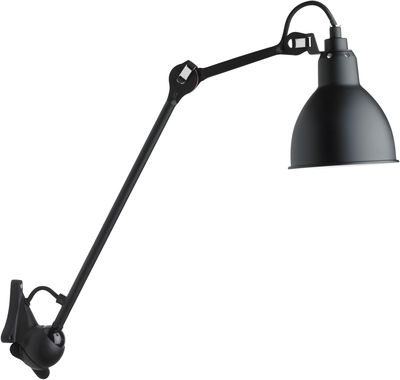
251.00 £
DCW éditions - Lampes Gras
DCW éditions - Lampes Gras Wall light Mat black Metal Long arm : L 38,8 cm / Short arm : L 20 cm - Shade : Ø 14 cm x H 17,5 cm In 1921 Bernard-Albin GRAS designed a series of lamps for use in offices and in industrial environments. The «GRAS» lamp, as it was subsequently called, was astounding in its simple, robust and yet very ergonomic design. There are neither screws nor welded joints in the basic form. In 1927 the RAVEL company purchased the patent and started production of the «GRAS» lamps. Bernard-Albin GRAS was one of the most innovative designer of the 20th century. The functional esthetic of his lamps and especially the design of details such as those of the arms, stems, brackets and bases were truly original and far ahead of his time. Early on Le Corbusier was seduced by the modern design and user-friendliness of the lamps and became one of Bernard-Albin GRAS's most enthusiastic supporters using the lamps in his own offices as well as employing them in numerous architectural projects all over the world. Others such as Robert Mallet-Stevens, Emile Jacques Ruhlmann and Eileen Gray followed this trend as well. Furthermore, such well-know artists as Sonia Delaunay and Georges Braque also used these lamps in their studios. For the first time in history, a lamp was equally popular in professional as well as in residential applications. Today, the «GRAS» lamp has become sought after a collector's item all over the world, most notably in France, in the United States and in Japan. Bernard-Albin Gras's talented and visionary design has proven to be timeless. Bulb (not included) : 1 x E14 40W
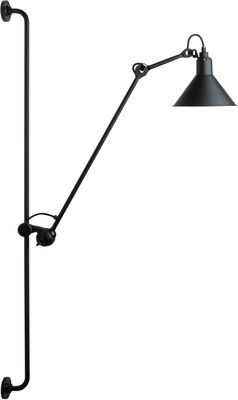
333.00 £
DCW éditions - Lampes Gras
DCW éditions - Lampes Gras Wall light Satin black Metal Wall bar : H 118 x D 8 cm - Long arm: L 59 cm / Short arm : L 20 cm - Shade : Ø 21 x H 18.5 cm In 1921 Bernard-Albin Gras Designed a series of lamps for use in offices and industrial environments. The Gras lamp, as it was subsequently called, was astounding in its simple, robust and yet very ergonomic design. There are neither screws nor welded joints in the basic form. Early on Le Corbusier was seduced by the modern design and user-friendliness of the lamp and became one of Bernard-Albin GRAS's most enthusiastic supporters using the lamps in his own offices as well as employing them in numerous architectural projects all over the world. For the first time in history, a lamp was equally popular in professional as well as in residential applications. Today, the Gras lamp has become sought after a collector's item all over the world, most notably in France, in the United States and in Japan. Bernard-Albin Gras's talented and visionary design has proven to be timeless... Adjustable in height : the base slides along the bar - A ball in bakelite inserted into the base train a joint with kneecap allowing movements in all directions of the arm - Mobile and directional Reflector - Bulb (not supplied): 1 x E14 40W
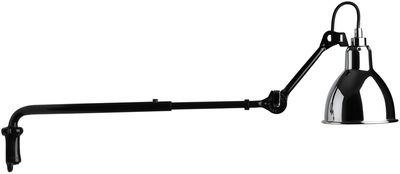
242.00 £
DCW éditions - Lampes Gras
DCW éditions - Lampes Gras Wall light Glossy black,Glossy metal Metal Adjustable long arm : min. L 49 cm / max. L 76 cm - small articulated arm : L 20 cm - Shade : Ø 14 cm x H 17.5 cm - Wall fixation : H 13 cm In 1921 Bernard-Albin GRAS designed a series of lamps for use in offices and in industrial environments. The «GRAS» lamp, as it was subsequently called, was astounding in its simple, robust and yet very ergonomic design. There are neither screws nor welded joints in the basic form. In 1927 the RAVEL company purchased the patent and started production of the «GRAS» lamps. Bernard-Albin GRAS was one of the most innovative designer of the 20th century. The functional esthetic of his lamps and especially the design of details such as those of the arms, stems, brackets and bases were truly original and far ahead of his time. Early on Le Corbusier was seduced by the modern design and user-friendliness of the lamps and became one of Bernard-Albin GRAS's most enthusiastic supporters using the lamps in his own offices as well as employing them in numerous architectural projects all over the world. Others such as Robert Mallet-Stevens, Emile Jacques Ruhlmann and Eileen Gray followed this trend as well. Furthermore, such well-know artists as Sonia Delaunay and Georges Braque also used these lamps in their studios. For the first time in history, a lamp was equally popular in professional as well as in residential applications. Today, the «GRAS» lamp has become sought after a collector's item all over the world, most notably in France, in the United States and in Japan. Bernard-Albin Gras's talented and visionary design has proven to be timeless. Electrical cable with EU plug (EU to UK adapter included) - A ball in bakelite inserted into the support train a joint with kneecap allowing movements in all directions of the arm - Mobile and directional Reflector - Bulb (not supplied): 1 x E14 - ESL 11W
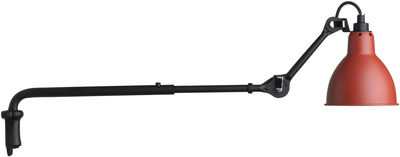
242.00 £
DCW éditions - Lampes Gras
DCW éditions - Lampes Gras Wall light Mat black,Matt red Metal Adjustable long arm : min. L 49 cm / max. L 76 cm - small articulated arm : L 20 cm - Shade : Ø 14 cm x H 17.5 cm - Wall fixation : H 13 cm In 1921 Bernard-Albin GRAS designed a series of lamps for use in offices and in industrial environments. The «GRAS» lamp, as it was subsequently called, was astounding in its simple, robust and yet very ergonomic design. There are neither screws nor welded joints in the basic form. In 1927 the RAVEL company purchased the patent and started production of the «GRAS» lamps. Bernard-Albin GRAS was one of the most innovative designer of the 20th century. The functional esthetic of his lamps and especially the design of details such as those of the arms, stems, brackets and bases were truly original and far ahead of his time. Early on Le Corbusier was seduced by the modern design and user-friendliness of the lamps and became one of Bernard-Albin GRAS's most enthusiastic supporters using the lamps in his own offices as well as employing them in numerous architectural projects all over the world. Others such as Robert Mallet-Stevens, Emile Jacques Ruhlmann and Eileen Gray followed this trend as well. Furthermore, such well-know artists as Sonia Delaunay and Georges Braque also used these lamps in their studios. For the first time in history, a lamp was equally popular in professional as well as in residential applications. Today, the «GRAS» lamp has become sought after a collector's item all over the world, most notably in France, in the United States and in Japan. Bernard-Albin Gras's talented and visionary design has proven to be timeless. Electrical cable with EU plug (EU to UK adapter included) - A ball in bakelite inserted into the support train a joint with kneecap allowing movements in all directions of the arm - Mobile and directional Reflector - Bulb (not supplied): 1 x E14 - ESL 11W
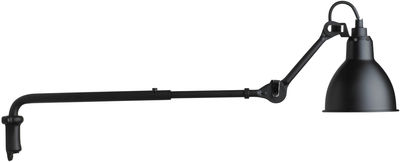
242.00 £
DCW éditions - Lampes Gras
DCW éditions - Lampes Gras Wall light Mat black Metal Adjustable long arm : min. L 49 cm / max. L 76 cm - small articulated arm : L 20 cm - Shade : Ø 14 cm x H 17.5 cm - Wall fixation : H 13 cm In 1921 Bernard-Albin GRAS designed a series of lamps for use in offices and in industrial environments. The «GRAS» lamp, as it was subsequently called, was astounding in its simple, robust and yet very ergonomic design. There are neither screws nor welded joints in the basic form. In 1927 the RAVEL company purchased the patent and started production of the «GRAS» lamps. Bernard-Albin GRAS was one of the most innovative designer of the 20th century. The functional esthetic of his lamps and especially the design of details such as those of the arms, stems, brackets and bases were truly original and far ahead of his time. Early on Le Corbusier was seduced by the modern design and user-friendliness of the lamps and became one of Bernard-Albin GRAS's most enthusiastic supporters using the lamps in his own offices as well as employing them in numerous architectural projects all over the world. Others such as Robert Mallet-Stevens, Emile Jacques Ruhlmann and Eileen Gray followed this trend as well. Furthermore, such well-know artists as Sonia Delaunay and Georges Braque also used these lamps in their studios. For the first time in history, a lamp was equally popular in professional as well as in residential applications. Today, the «GRAS» lamp has become sought after a collector's item all over the world, most notably in France, in the United States and in Japan. Bernard-Albin Gras's talented and visionary design has proven to be timeless. Electrical cable with EU plug (EU to UK adapter included) - A ball in bakelite inserted into the support train a joint with kneecap allowing movements in all directions of the arm - Mobile and directional Reflector - Bulb (not supplied): 1 x E14 - ESL 11W
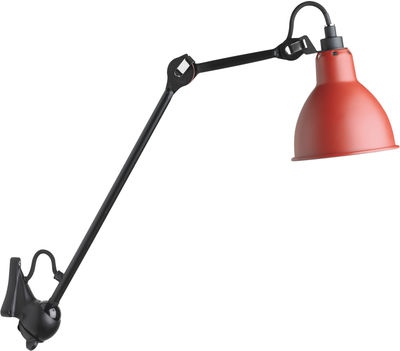
251.00 £
DCW éditions - Lampes Gras
DCW éditions - Lampes Gras Wall light Mat black,Matt red Metal Long arm : L 38,8 cm / Short arm : L 20 cm - Shade : Ø 14 cm x H 17,5 cm In 1921 Bernard-Albin GRAS designed a series of lamps for use in offices and in industrial environments. The «GRAS» lamp, as it was subsequently called, was astounding in its simple, robust and yet very ergonomic design. There are neither screws nor welded joints in the basic form. In 1927 the RAVEL company purchased the patent and started production of the «GRAS» lamps. Bernard-Albin GRAS was one of the most innovative designer of the 20th century. The functional esthetic of his lamps and especially the design of details such as those of the arms, stems, brackets and bases were truly original and far ahead of his time. Early on Le Corbusier was seduced by the modern design and user-friendliness of the lamps and became one of Bernard-Albin GRAS's most enthusiastic supporters using the lamps in his own offices as well as employing them in numerous architectural projects all over the world. Others such as Robert Mallet-Stevens, Emile Jacques Ruhlmann and Eileen Gray followed this trend as well. Furthermore, such well-know artists as Sonia Delaunay and Georges Braque also used these lamps in their studios. For the first time in history, a lamp was equally popular in professional as well as in residential applications. Today, the «GRAS» lamp has become sought after a collector's item all over the world, most notably in France, in the United States and in Japan. Bernard-Albin Gras's talented and visionary design has proven to be timeless. A ball in bakelite inserted into the support train a joint with kneecap allowing movements in all directions of the arm - Mobile and directional Reflector - Bulb (not supplied): 1 x E14 40W
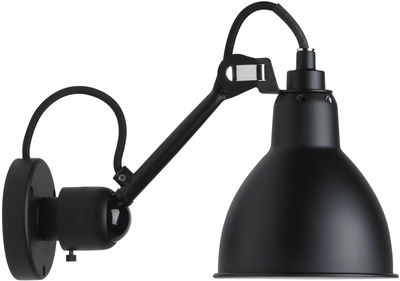
199.00 £
DCW éditions - Lampes Gras
DCW éditions - Lampes Gras Wall light Mat black Metal Total length extending arm : 41 cm (Arm length : 17 cm) - Shade : Ø 14 cm x H 17,5 cm - Wall support : Ø 9,5 cm In 1921 Bernard-Albin GRAS designed a series of lamps for use in offices and in industrial environments. The «GRAS» lamp, as it was subsequently called, was astounding in its simple, robust and yet very ergonomic design. There are neither screws nor welded joints in the basic form. In 1927 the RAVEL company purchased the patent and started production of the «GRAS» lamps. Bernard-Albin GRAS was one of the most innovative designer of the 20th century. The functional esthetic of his lamps and especially the design of details such as those of the arms, stems, brackets and bases were truly original and far ahead of his time. Early on Le Corbusier was seduced by the modern design and user-friendliness of the lamps and became one of Bernard-Albin GRAS's most enthusiastic supporters using the lamps in his own offices as well as employing them in numerous architectural projects all over the world. Others such as Robert Mallet-Stevens, Emile Jacques Ruhlmann and Eileen Gray followed this trend as well. Furthermore, such well-know artists as Sonia Delaunay and Georges Braque also used these lamps in their studios. For the first time in history, a lamp was equally popular in professional as well as in residential applications. Today, the «GRAS» lamp has become sought after a collector's item all over the world, most notably in France, in the United States and in Japan. Bernard-Albin Gras's talented and visionary design has proven to be timeless. A ball in bakelite inserted into the support train a joint with kneecap allowing movements in all directions of the arm - Mobile and directional Reflector - Bulb (not supplied): 1 x E14 - ESL 11W - On/Off switch on the base
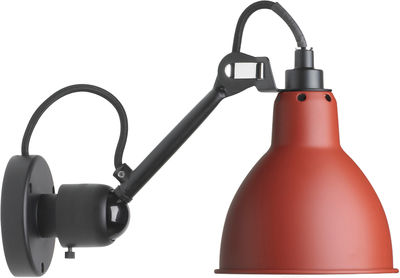
199.00 £
DCW éditions - Lampes Gras
DCW éditions - Lampes Gras Wall light Mat black,Matt red Metal Total length extending arm : 41 cm (Arm length : 17 cm) - Shade : Ø 14 cm x H 17,5 cm - Wall support : Ø 9,5 cm In 1921 Bernard-Albin GRAS designed a series of lamps for use in offices and in industrial environments. The «GRAS» lamp, as it was subsequently called, was astounding in its simple, robust and yet very ergonomic design. There are neither screws nor welded joints in the basic form. In 1927 the RAVEL company purchased the patent and started production of the «GRAS» lamps. Bernard-Albin GRAS was one of the most innovative designer of the 20th century. The functional esthetic of his lamps and especially the design of details such as those of the arms, stems, brackets and bases were truly original and far ahead of his time. Early on Le Corbusier was seduced by the modern design and user-friendliness of the lamps and became one of Bernard-Albin GRAS's most enthusiastic supporters using the lamps in his own offices as well as employing them in numerous architectural projects all over the world. Others such as Robert Mallet-Stevens, Emile Jacques Ruhlmann and Eileen Gray followed this trend as well. Furthermore, such well-know artists as Sonia Delaunay and Georges Braque also used these lamps in their studios. For the first time in history, a lamp was equally popular in professional as well as in residential applications. Today, the «GRAS» lamp has become sought after a collector's item all over the world, most notably in France, in the United States and in Japan. Bernard-Albin Gras's talented and visionary design has proven to be timeless. A ball in bakelite inserted into the support train a joint with kneecap allowing movements in all directions of the arm - Mobile and directional Reflector - Bulb (not supplied): 1 x E14 - ESL 11W - On/Off switch on the base

285.00 £
DCW éditions - Lampes Gras
DCW éditions - Lampes Gras Wall light Mat black Metal Extending arm : min. L 107 cm / max. L 146 cm + short articulated arm : L 20 cm - Shade : Ø 14 x H 17.5 cm - Bent height : H 13 cm -Wall fixation : larg. 5.8 cm In 1921 Bernard-Albin GRAS designed a series of lamps for use in offices and in industrial environments. The «GRAS» lamp, as it was subsequently called, was astounding in its simple, robust and yet very ergonomic design. There are neither screws nor welded joints in the basic form. In 1927 the RAVEL company purchased the patent and started production of the «GRAS» lamps. Bernard-Albin GRAS was one of the most innovative designer of the 20th century. The functional esthetic of his lamps and especially the design of details such as those of the arms, stems, brackets and bases were truly original and far ahead of his time. Early on Le Corbusier was seduced by the modern design and user-friendliness of the lamps and became one of Bernard-Albin GRAS's most enthusiastic supporters using the lamps in his own offices as well as employing them in numerous architectural projects all over the world. Others such as Robert Mallet-Stevens, Emile Jacques Ruhlmann and Eileen Gray followed this trend as well. Furthermore, such well-know artists as Sonia Delaunay and Georges Braque also used these lamps in their studios. For the first time in history, a lamp was equally popular in professional as well as in residential applications. Today, the «GRAS» lamp has become sought after a collector's item all over the world, most notably in France, in the United States and in Japan. Bernard-Albin Gras's talented and visionary design has proven to be timeless. A ball in bakelite inserted into the support train a joint with kneecap allowing movements in all directions of the arm - Mobile and directional Reflector - Bulb (not supplied): 1 x E14 - ESL 11W
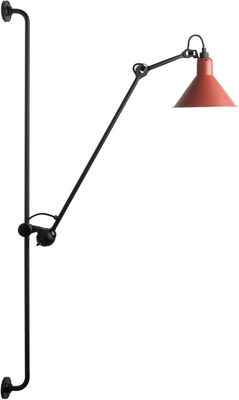
333.00 £
DCW éditions - Lampes Gras
DCW éditions - Lampes Gras Wall light Mat black,Matt red Metal Wall bar : H 118 x D 8 cm - Long arm: L 59 cm / Short arm : L 20 cm - Shade : Ø 21 x H 18.5 cm In 1921 Bernard-Albin Gras Designed a series of lamps for use in offices and industrial environments. The Gras lamp, as it was subsequently called, was astounding in its simple, robust and yet very ergonomic design. There are neither screws nor welded joints in the basic form. Early on Le Corbusier was seduced by the modern design and user-friendliness of the lamp and became one of Bernard-Albin GRAS's most enthusiastic supporters using the lamps in his own offices as well as employing them in numerous architectural projects all over the world. For the first time in history, a lamp was equally popular in professional as well as in residential applications. Today, the Gras lamp has become sought after a collector's item all over the world, most notably in France, in the United States and in Japan. Bernard-Albin Gras's talented and visionary design has proven to be timeless... Adjustable in height : the base slides along the bar - A ball in bakelite inserted into the base train a joint with kneecap allowing movements in all directions of the arm - Mobile and directional Reflector - Bulb (not supplied): 1 x E14 40W
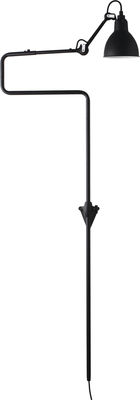
322.00 £
DCW éditions - Lampes Gras
DCW éditions - Lampes Gras Wall light Mat black Metal Wall bar height : H 108 cm / Bent height : H 16 cm - Lenght arm : max. L 76 cm (unfolded) / min. L 34 cm (folded) ' Arm 1 : L 34 cm / Arm 2 : L 41 cm / Short arm (bielle) : L 20 cm - Shade : Ø 14 x H 17.5 cm In 1921 Bernard-Albin Gras Designed a series of lamps for use in offices and industrial environments. The Gras lamp, as it was subsequently called, was astounding in its simple, robust and yet very ergonomic design. There are neither screws nor welded joints in the basic form. Early on Le Corbusier was seduced by the modern design and user-friendliness of the lamp and became one of Bernard-Albin GRAS's most enthusiastic supporters using the lamps in his own offices as well as employing them in numerous architectural projects all over the world. For the first time in history, a lamp was equally popular in professional as well as in residential applications. Today, the Gras lamp has become sought after a collector's item all over the world, most notably in France, in the United States and in Japan. Bernard-Albin Gras's talented and visionary design has proven to be timeless... Adjustable in height : the base slides along the bar - Mobile and directional Reflector - Bulb (not supplied): 1 x E14 11W
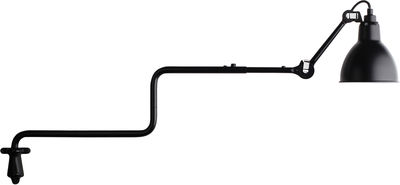
275.00 £
DCW éditions - Lampes Gras
DCW éditions - Lampes Gras Wall light Mat black Metal Total lenght arm : min. L 34 cm (folded) / max. L 70 cm (unfolded) ' Arm 1 : L 36 cm / Arm 2 : L 34 cm / Arm 3 : (short arm) L 20 cm- Height : H 13 cm + H 16 cm ' Shade : Ø 14 x H 17.5 cm In 1921 Bernard-Albin Gras Designed a series of lamps for use in offices and industrial environments. The Gras lamp, as it was subsequently called, was astounding in its simple, robust and yet very ergonomic design. There are neither screws nor welded joints in the basic form. Early on Le Corbusier was seduced by the modern design and user-friendliness of the lamp and became one of Bernard-Albin GRAS's most enthusiastic supporters using the lamps in his own offices as well as employing them in numerous architectural projects all over the world. For the first time in history, a lamp was equally popular in professional as well as in residential applications. Today, the Gras lamp has become sought after a collector's item all over the world, most notably in France, in the United States and in Japan. Bernard-Albin Gras's talented and visionary design has proven to be timeless... Wall lamp fitted with a cable ended by plug (needs to be plugged into a socket). Cable with plug (needs to be plugged into a socket) - Mobile and directional Reflector - Bulb (not supplied): 1 x E14 11W
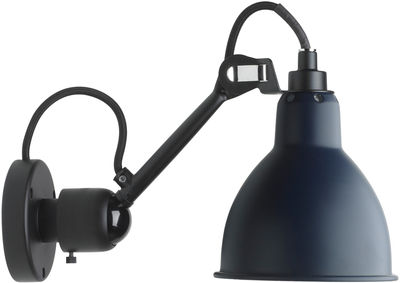
199.00 £
DCW éditions - Lampes Gras
DCW éditions - Lampes Gras Wall light Mat black,Matt blue Metal Total length extending arm : 41 cm (Arm length : 17 cm) - Shade : Ø 14 cm x H 17,5 cm - Wall support : Ø 9,5 cm In 1921 Bernard-Albin GRAS designed a series of lamps for use in offices and in industrial environments. The «GRAS» lamp, as it was subsequently called, was astounding in its simple, robust and yet very ergonomic design. There are neither screws nor welded joints in the basic form. In 1927 the RAVEL company purchased the patent and started production of the «GRAS» lamps. Bernard-Albin GRAS was one of the most innovative designer of the 20th century. The functional esthetic of his lamps and especially the design of details such as those of the arms, stems, brackets and bases were truly original and far ahead of his time. Early on Le Corbusier was seduced by the modern design and user-friendliness of the lamps and became one of Bernard-Albin GRAS's most enthusiastic supporters using the lamps in his own offices as well as employing them in numerous architectural projects all over the world. Others such as Robert Mallet-Stevens, Emile Jacques Ruhlmann and Eileen Gray followed this trend as well. Furthermore, such well-know artists as Sonia Delaunay and Georges Braque also used these lamps in their studios. For the first time in history, a lamp was equally popular in professional as well as in residential applications. Today, the «GRAS» lamp has become sought after a collector's item all over the world, most notably in France, in the United States and in Japan. Bernard-Albin Gras's talented and visionary design has proven to be timeless. A ball in bakelite inserted into the support train a joint with kneecap allowing movements in all directions of the arm - Mobile and directional Reflector - Bulb (not supplied): 1 x E14 - ESL 11W - On/Off switch on the base
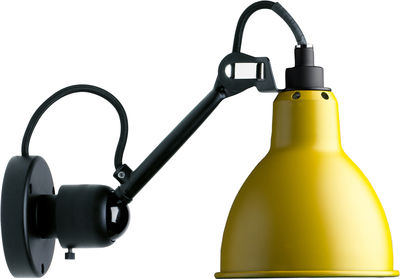
199.00 £
DCW éditions - Lampes Gras
DCW éditions - Lampes Gras Wall light Mat black,Matt yellow Metal Total length extending arm : 41 cm (Arm length : 17 cm) - Shade : Ø 14 cm x H 17,5 cm - Wall support : Ø 9,5 cm In 1921 Bernard-Albin GRAS designed a series of lamps for use in offices and in industrial environments. The «GRAS» lamp, as it was subsequently called, was astounding in its simple, robust and yet very ergonomic design. There are neither screws nor welded joints in the basic form. In 1927 the RAVEL company purchased the patent and started production of the «GRAS» lamps. Bernard-Albin GRAS was one of the most innovative designer of the 20th century. The functional esthetic of his lamps and especially the design of details such as those of the arms, stems, brackets and bases were truly original and far ahead of his time. Early on Le Corbusier was seduced by the modern design and user-friendliness of the lamps and became one of Bernard-Albin GRAS's most enthusiastic supporters using the lamps in his own offices as well as employing them in numerous architectural projects all over the world. Others such as Robert Mallet-Stevens, Emile Jacques Ruhlmann and Eileen Gray followed this trend as well. Furthermore, such well-know artists as Sonia Delaunay and Georges Braque also used these lamps in their studios. For the first time in history, a lamp was equally popular in professional as well as in residential applications. Today, the «GRAS» lamp has become sought after a collector's item all over the world, most notably in France, in the United States and in Japan. Bernard-Albin Gras's talented and visionary design has proven to be timeless. A ball in bakelite inserted into the support train a joint with kneecap allowing movements in all directions of the arm - Mobile and directional Reflector - Bulb (not supplied): 1 x E14 - ESL 11W - On/Off switch on the base
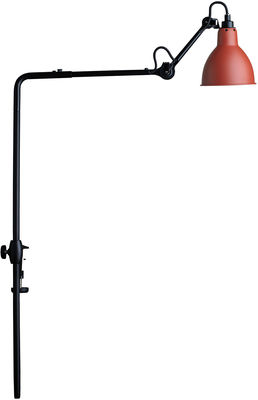
263.00 £
DCW éditions - Lampes Gras
DCW éditions - Lampes Gras Lamp Red,Black Metal Vertical bar : H 85 cm (ajustable height) - Long arm : L 41 cm - Short arm : L 20 cm - Shade : Ø 14 cm x H 17.5 cm In 1921 Bernard-Albin Gras Designed a series of lamps for use in offices and industrial environments. The Gras lamp, as it was subsequently called, was astounding in its simple, robust and yet very ergonomic design.There are neither screws nor welded joints in the basic form. Early on Le Corbusier was seduced by the modern design and user-friendliness of the lamp and became one of Bernard-Albin GRAS's most enthusiastic supporters using the lamps in his own offices as well as employing them in numerous architectural projects all over the world.For the first time in history, a lamp was equally popular in professional as well as in residential applications. Today, the Gras lamp has become sought after a collector's item all over the world, most notably in France, in the United States and in Japan. Bernard-Albin Gras's talented and visionary design has proven to be timeless... Supplied with EU plug : EU to UK plug adapter included - Can be fixed on shelves (for a shelf with 5,3 cm Depth maximum)
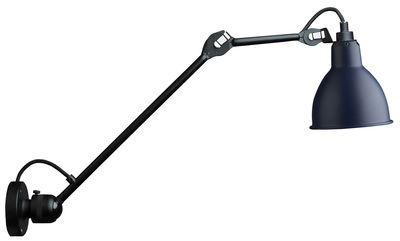
259.00 £
DCW éditions - Lampes Gras
DCW éditions - Lampes Gras Wall light Blue Metal Bras : L 59 cm (large arm L 39 cm + samll arm L 20 cm) - Shade : Ø 14 cm x H 17,5 cm - Wall fixation : Ø 9,5 cm In 1921 Bernard-Albin Gras Designed a series of lamps for use in offices and industrial environments. The Gras lamp, as it was subsequently called, was astounding in its simple, robust and yet very ergonomic design.There are neither screws nor welded joints in the basic form. Early on Le Corbusier was seduced by the modern design and user-friendliness of the lamp and became one of Bernard-Albin GRAS's most enthusiastic supporters using the lamps in his own offices as well as employing them in numerous architectural projects all over the world.For the first time in history, a lamp was equally popular in professional as well as in residential applications. Today, the Gras lamp has become sought after a collector's item all over the world, most notably in France, in the United States and in Japan. Bernard-Albin Gras's talented and visionary design has proven to be timeless... Bulb not provided : 1 x E14 - ESL11W
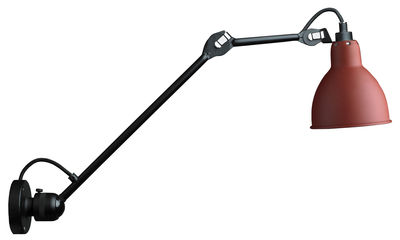
259.00 £
DCW éditions - Lampes Gras
DCW éditions - Lampes Gras Wall light Red Metal Bras : L 59 cm (large arm L 39 cm + samll arm L 20 cm) - Shade : Ø 14 cm x H 17,5 cm - Wall fixation : Ø 9,5 cm In 1921 Bernard-Albin Gras Designed a series of lamps for use in offices and industrial environments. The Gras lamp, as it was subsequently called, was astounding in its simple, robust and yet very ergonomic design.There are neither screws nor welded joints in the basic form. Early on Le Corbusier was seduced by the modern design and user-friendliness of the lamp and became one of Bernard-Albin GRAS's most enthusiastic supporters using the lamps in his own offices as well as employing them in numerous architectural projects all over the world.For the first time in history, a lamp was equally popular in professional as well as in residential applications. Today, the Gras lamp has become sought after a collector's item all over the world, most notably in France, in the United States and in Japan. Bernard-Albin Gras's talented and visionary design has proven to be timeless... Bulb not provided : 1 x E14 - ESL11W
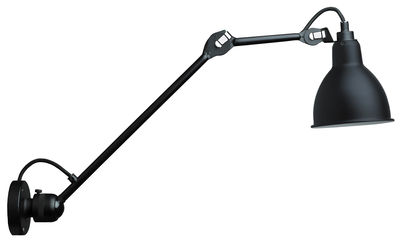
259.00 £
DCW éditions - Lampes Gras
DCW éditions - Lampes Gras Wall light Black Metal Bras : L 59 cm (large arm L 39 cm + samll arm L 20 cm) - Shade : Ø 14 cm x H 17,5 cm - Wall fixation : Ø 9,5 cm In 1921 Bernard-Albin Gras Designed a series of lamps for use in offices and industrial environments. The Gras lamp, as it was subsequently called, was astounding in its simple, robust and yet very ergonomic design.There are neither screws nor welded joints in the basic form. Early on Le Corbusier was seduced by the modern design and user-friendliness of the lamp and became one of Bernard-Albin GRAS's most enthusiastic supporters using the lamps in his own offices as well as employing them in numerous architectural projects all over the world.For the first time in history, a lamp was equally popular in professional as well as in residential applications. Today, the Gras lamp has become sought after a collector's item all over the world, most notably in France, in the United States and in Japan. Bernard-Albin Gras's talented and visionary design has proven to be timeless... Bulb not provided : 1 x E14 - ESL11W
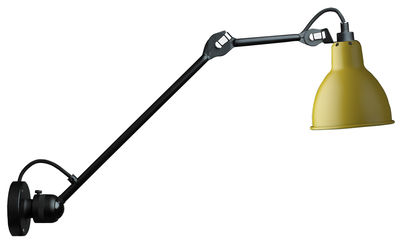
259.00 £
DCW éditions - Lampes Gras
DCW éditions - Lampes Gras Wall light Yellow Metal Bras : L 59 cm (large arm L 39 cm + samll arm L 20 cm) - Shade : Ø 14 cm x H 17,5 cm - Wall fixation : Ø 9,5 cm In 1921 Bernard-Albin Gras Designed a series of lamps for use in offices and industrial environments. The Gras lamp, as it was subsequently called, was astounding in its simple, robust and yet very ergonomic design.There are neither screws nor welded joints in the basic form. Early on Le Corbusier was seduced by the modern design and user-friendliness of the lamp and became one of Bernard-Albin GRAS's most enthusiastic supporters using the lamps in his own offices as well as employing them in numerous architectural projects all over the world.For the first time in history, a lamp was equally popular in professional as well as in residential applications. Today, the Gras lamp has become sought after a collector's item all over the world, most notably in France, in the United States and in Japan. Bernard-Albin Gras's talented and visionary design has proven to be timeless... Bulb not provided : 1 x E14 - ESL11W